tire pressure AUDI A5 CABRIOLET 2015 Owners Manual
[x] Cancel search | Manufacturer: AUDI, Model Year: 2015, Model line: A5 CABRIOLET, Model: AUDI A5 CABRIOLET 2015Pages: 268, PDF Size: 66.88 MB
Page 5 of 268

M N
ci u.. co ,...., \!) 1.1'1
N 1.1'1 ,....,
Safety belts . . . . . . . . . . . . . . . . . . . . . . . . 12 7
Belt tensioners . . . . . . . . . . . . . . . . . . . . . . 130
Airbag system ............... .. ... 132
Important information . . . . . . . . . . . . . . . 132
Fr ont airbags . . . . . . . . . . . . . . . . . . . . . . . 136
Monitoring the Advanced Airbag System . 142
Knee airbags . . . . . . . . . . . . . . . . . . . . . . . . 146
Side airbags . . . . . . . . . . . . . . . . . . . . . . . . 148
Child safety . . . . . . . . . . . . . . . . . . . . . . 152
Important information . . . . . . . . . . . . . . . 152
Ch ild seats . . . . . . . . . . . . . . . . . . . . . . . . . 157
Securing child seats . . . . . . . . . . . . . . . . . . 16 1
L A TCH system (Lower anchorages and
tethers for children) . . . . . . . . . . . . . . . . . . 165
Additional information 168
Driver messages . . . . . . . . . . . . . . . . . 169
Smart Technology . . . . . . . . . . . . . . . 169
Notice about data recorded by the Event
Dat a Recorder and vehicle control
modules . . . . . . . . . . . . . . . . . . . . . . . . . . . 169
Electronic Stabili zation Control ( ESC) . . . . 170
Braking . . . . . . . . . . . . . . . . . . . . . . . . . . . . 172
Electro-mechanical power assist, dynamic
steering . . . . . . . . . . . . . . . . . . . . . . . . . . . 174
Driving with your quattro . . . . . . . . . . . . . 17 4
E ne rgy management . . . . . . . . . . . . . . . . . 175
Driving and the environment . . . . 177
Breaking in . . . . . . . . . . . . . . . . . . . . . . . . . 177
Avoid damaging the vehicle . . . . . . . . . . . . 177
Driving through water on roads . . . . . . . . 177
Catalytic converter................... 178
Shutting down vehicle . . . . . . . . . . . . . . . . 178
Economical and environmentally -friend ly
driving . . . . . . . . . . . . . . . . . . . . . . . . . . . . 179
Trailer mode . . . . . . . . . . . . . . . . . . . . . . 181
Driving with a t railer . . . . . . . . . . . . . . . . . 181
Trailer mode notes . . . . . . . . . . . . . . . . . . . 183
Operating instructions . . . . . . . . . . . 184
Care and cleaning . . . . . . . . . . . . . . . . 184
General information . . . . . . . . . . . . . . . . . 184
Car washes . . . . . . . . . . . . . . . . . . . . . . . . . 184
Table of contents
Cleaning and care information . . . . . . . . . 185
Placing your vehicle out of service . . . . . . 188
Fuel and Refueling . . . . . . . . . . . . . . . 190
Fuel . . . . . . . . . . . . . . . . . . . . . . . . . . . . . . . 190
Refueling . . . . . . . . . . . . . . . . . . . . . . . . . . 192
Checking and Filling . . . . . . . . . . . . . 195
Hood . . . . . . . . . . . . . . . . . . . . . . . . . . . . . . 195
Engine compartment . . . . . . . . . . . . . . . . . 197
Engine oil . . . . . . . . . . . . . . . . . . . . . . . . . . 197
Cooling system . . . . . . . . . . . . . . . . . . . . . . 200
Brake fluid . . . . . . . . . . . . . . . . . . . . . . . . . 203
Battery . . . . . . . . . . . . . . . . . . . . . . . . . . . . 204
Windshield/headlight* washer container. 208
Wheels ...... .. .. ........ ...... ... 209
Wheels and Tires . . . . . . . . . . . . . . . . . . . . 209
T ire pressure monitoring system 226
Troubleshooting . . . . . . . . . . . . . . . . . 229
Emergency assistance . . . . . . . . . . . 229
Vehicle tool kit . . . . . . . . . . . . . . . . . . . . . . 229
Space-saving spare tire (compact spare
tire) . . . . . . . . . . . . . . . . . . . . . . . . . . . . . . . 229
Replacing wheels . . . . . . . . . . . . . . . . . . . . 230
Fuses and bulbs . . . . . . . . . . . . . . . . . . 236
Fuses.............................. 236
Bulbs. . . . . . . . . . . . . . . . . . . . . . . . . . . . . . 239
Emergency situations . . . . . . . . . . . . 240
General . . . . . . . . . . . . . . . . . . . . . . . . . . . . 240
Starting by pushing or towing . . . . . . . . . . 240
Start ing with jumper cables . . . . . . . . . . . 240
Use of jumper cables . . . . . . . . . . . . . . . . . 241
Towing with a tow truck . . . . . . . . . . . . . . . 242
Raising the vehicle . . . . . . . . . . . . . . . . . . . 244
Technical data . . . . . . . . . . . . . . . . . . . . 245
Technical data . . . . . . . . . . . . . . . . . . . . 245
Vehicle identification . . . . . . . . . . . . . . . . . 245
Weights . . . . . . . . . . . . . . . . . . . . . . . . . . . 24S
Dimensions . . . . . . . . . . . . . . . . . . . . . . . . . 246
3
Page 16 of 268

Instruments and indicator lights
"O~ I I ~ .,
14
Electronic Stabilization Control
( E SC)
<=:> page 170
USA models :
Anti-lock braking system (ABS) de
fective./
c::> page 19
Canada models :
Anti-lock braking system (ABS) de
fective./
<=:> page 19
USA models :
Safety systems ./
<=:>page 19
Canada model s:
Safety systems ./
<=:>page 19
Worn brake pads
c::>page20
Electromechanical parking brake
<=:>page 16
Tire pressure monitoring
system./
c::> page 2 2 7
Tire pressure moni toring sys tem
c::> page 2 2 7
Elect ro nic power control./
c::>page20
Malfunct ion ind icator Lamp (MIL)
./
c::> page20
Engine speed limit ation
c::> page20
Engine oil level
<=:> page 17
Engine oil sensor
c::> page20
Batte ry
<=:> page 16
Ta nk sys tem
c::> page20
Warm up e ng ine*
c::> page 191
Windsh ie ld washer fluid level
<=:> page 21
Windshie ld wipers
<=:> page 21
Remote contro l key
<=:> page 75
Battery in remo te control key
<=:> page 31
Defec tive light bulb wa rning
<=:> page 21
Fog lights
<=:>page 21
Rear fog lig ht(s)*
<=:> page 21
Headlight range control*
<=:> page 21
Adaptive light*
<=>page 21
Light -/rain sensor*
<=> page 21
Adaptive dampers*
<=>pag e22
Spor t differen tial *
<=>page22
Ig nition loc k
<=>page2 2
Steering co lumn lock
<=> page 18
Electromechanica l steer ing,
dynam ic steer ing*
./ <=:> page 174
Transmission
- mu ltit ronic, tiptronic
<=> page 88
- S tronic c::> page 88
Transmission
- S tronic
<=> page 88
Other indicator light s
--------------
Turn signals
<=>page22
Page 115 of 268
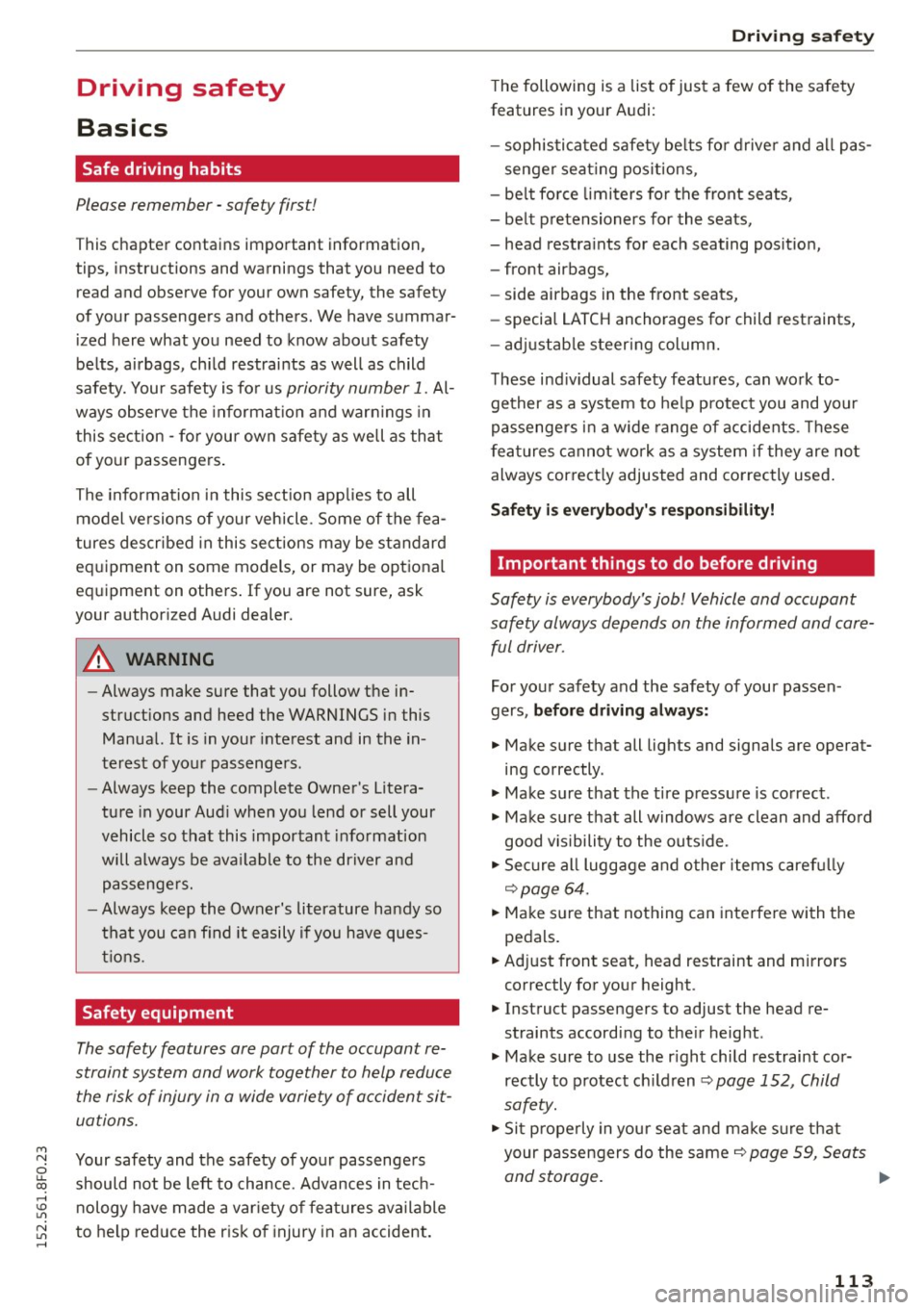
Driving safety
Basics
Safe driving habits
Please remember -safety first!
This chapter contains important information,
tips, instructions and warnings that you need to
read and observe for your own safety, the safety
of your passengers and others . We have summar
ized here what you need to know about safety
belts, airbags , chi ld restraints as well as child
safety. Your safety is for us
priority number 1. Al
ways observe the informat ion and warn ings in
this section - for your own safety as well as that
of your passengers .
The information in this section app lies to all
model ve rsions of your vehicle . Some of the fea
tures described in this sections may be standard
equipment on some models, or may be optional
eq uipment on others .
If you are not sure, ask
your authorized Audi dealer.
A WARNING
- Always make sure that you follow the in
struct ions and heed the WARNINGS in this
Manual. It is in your interest and in the in
terest of your passengers.
- Always keep the complete Owne r's Litera
ture in your Aud i when you lend or sell your
vehicle so that this important info rmation
will always be ava ilable to the driver and
passenge rs.
-
- Always keep the Owner's literature handy so
that you can find it easily if you have ques
tions.
Safety equipment
The safety features are part of the occupant re
straint system and work together to help reduce
the risk of injury in a wide variety of accident sit
uations.
M
6 Your safety and the safety of your passenge rs
~ should not be left to chance. Advances in tec h-,...., \!) 1.1'1
N 1.1'1 ,....,
nology have made a var iety of fea tures available
to help reduce the r isk o f injury in an accident.
Dr ivin g s afet y
The following is a list of just a few of the sa fety
features in your A udi:
- sophisticated s afety be lts fo r drive r and a ll pas-
senger seat ing pos itions,
- be lt fo rce limi ters for the front seats,
- belt pretensioners for the seats,
- head restra ints for each seating posit ion,
- front airbags,
- side airbags in the front seats,
- special LATCH anchorages for child rest raints,
- ad justab le steer ing column.
These ind iv idual safety features, can wo rk to
gether as a system to he lp p rotect you and you r
passengers in a w ide range of accidents . T hese
f ea tures cannot work as a system if they are not
always cor rect ly adjusted and correctly used .
Safet y is eve rybod y's res pon sibilit y!
Important things to do before driving
Safety is everybody 's job! Vehicle and occupant
safety always depends on the informed and care
f1,1l driver .
For you r safety and the safety of your passen
gers,
b efore driv ing alway s:
.,. Make sure that all lights and signals are operat
ing correctly .
.,. Make sure that the tire pressure is co rrect .
.,. Make s ure that all w indows are clean and afford
good vis ibility to the outs ide.
.,. Sec ure all luggage and other items caref ully
qpage 64.
.,. Make s ure that nothing can interfere with the
pedals.
.,. Adjust front seat, head restraint and mirrors
correctly for your height .
.,. Instruct passengers to adjust the head re
straints according to the ir height .
.,. Make su re to use the r ight child restraint cor
rectly to protect ch ildren
q page 152, Child
safety.
.,. Si t properly in your seat and ma ke s ure that
your passengers do the same
q page 59, Seats
and storage. .,.
113
Page 122 of 268
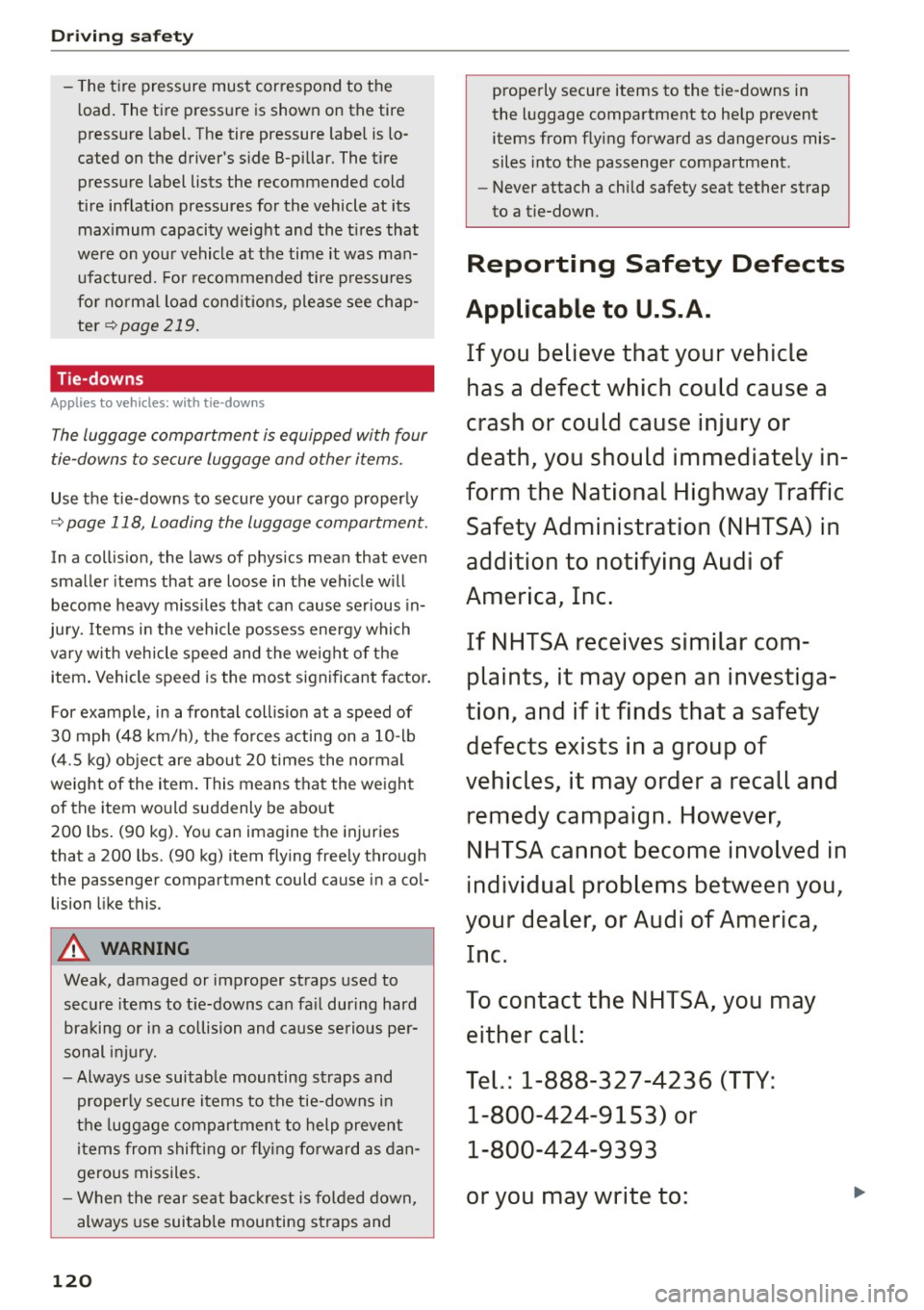
Driving safet y
- The tire pressure must cor respond to the
l oad . The tire press ure is shown on the tire
pressure label. The tire pressure labe l is lo
cated on the driver's s ide B-pillar. The tire
pressure label lists the recommended cold
tire inflation pressures for the vehicle at its max imum capacity weight and the t ires that
were on you r vehicle at the time it was man
ufa ctu red. For re comme nded ti re p ress ures
fo r normal load cond itions, please see chap
ter
<=> page 219 .
Tie-downs
Applies to vehicles: with tie-downs
The Luggage compartment is equipped with four
tie-downs to secure Luggage and other i tems.
Use the tie-downs to secure your cargo properly
<=> page 118, Loading the luggage compartment.
In a coll is io n, the laws of phys ics mean that even
smaller items that are loose in the vehicle w ill
become heavy m iss iles that can cause serious in
jury. Items i n the vehicle possess energy which
vary w ith vehicle speed and the weight of the
item . Vehicle speed is the most significant factor .
For examp le, in a frontal coll is ion at a speed of
30 mph (48 km/h), the fo rces acting on a 10-lb
( 4 .5 kg) obje ct are abou t 20 times the normal
weight of the item. This means that the we ight
of the item would suddenly be abo ut
200 lbs . (90 kg). Yo u can imagine the injuries
that a 200 lbs. (90 kg) item flying free ly through
t he passenger compartmen t could cause in a co l
lision like this.
A WARNING
Weak, damaged or improper straps used to
secure items to t ie-downs ca n fa il during hard
braking or in a collision and ca use serious pe r
sonal i njury.
- Always use suitable mounting straps and
properly secure items to the tie-downs i n
t h e luggage compartment to help prevent
items from shifting or f ly ing fo rward as dan
gerous missiles .
- When the re ar seat bac krest is folded down,
always use suitable mounting s traps and
120
-
properly secure items to the t ie-downs in
the l uggage compartment to help prevent
items from flying forward as dangerous mis
siles into the passenger compartment .
- Never attach a child safety seat tether strap
to a tie-down.
Reporting Safety Defects
Applicable to U.S.A.
If you believe that your vehicle
has a d efect which could cause a
crash or could cause injury or
death, you should immediatel y in
form the Nat ional High way Traffic
S afet y Administration (NH TSA ) in
addition t o notify ing Audi of
America, Inc.
If NHTSA re cei ves similar com
pl aint s, it ma y open an in ves tiga
tion , and if it find s that a safety
defe cts exists in a group of
v ehi cles, it ma y order a recall and
remed y campaign . Howe ver ,
NHTSA cannot become in vol ve d in
indi vidu al pr oblem s betw een you ,
your deal er, o r A udi of Am eri ca ,
In c.
To contact the NHTSA, you ma y
eith er call:
T el.: 1-888-327-4236 (TTY :
1 -800-424 -915 3) or
1 -800-424-9 393
or you may write to :
Page 184 of 268
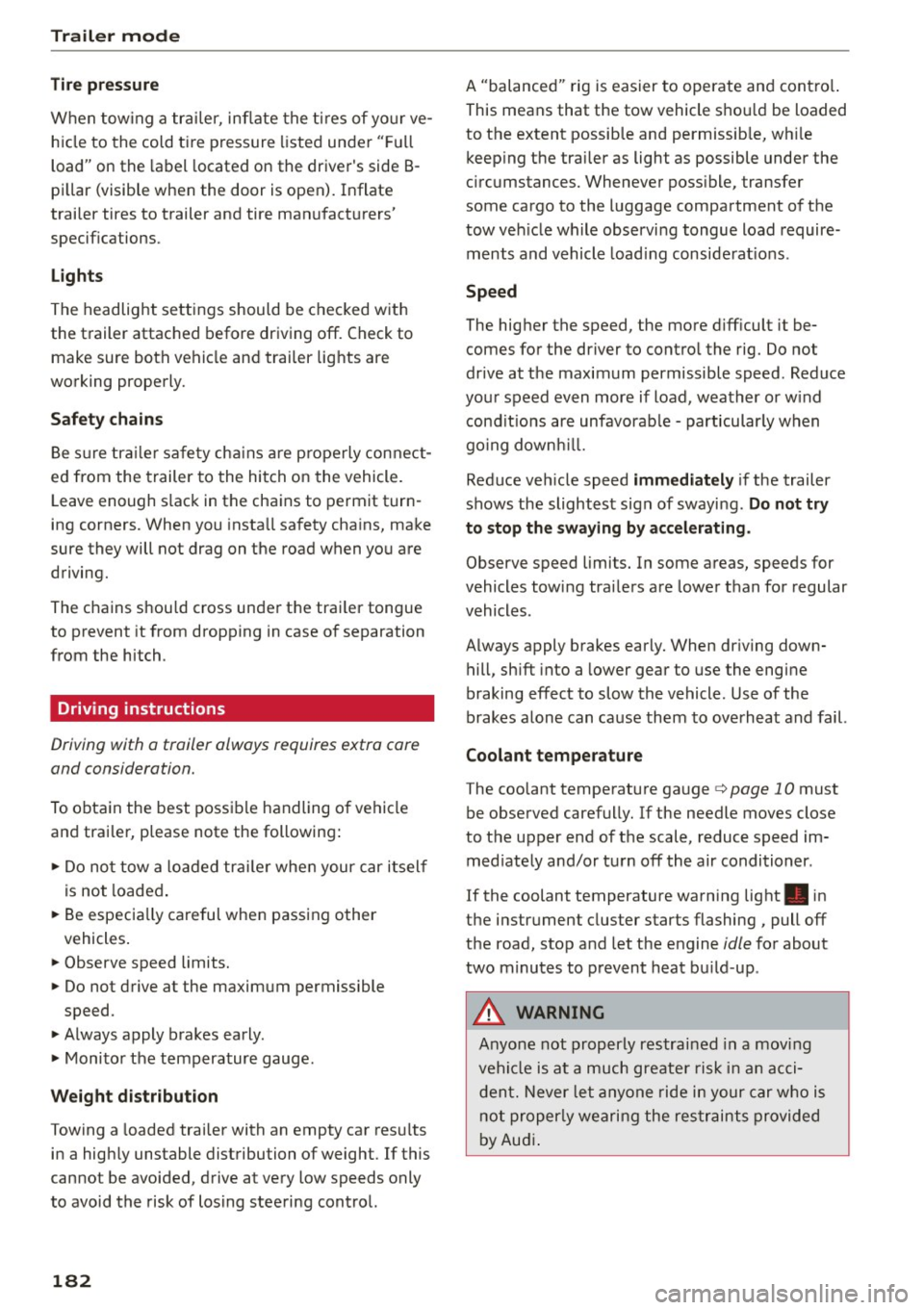
Trailer mode
Tire pressure
When tow ing a trailer, inflate the tires of your ve
hicle to the cold tire pressure listed under " Full
load" on the label located on the driver's side B
pillar (visible when the door is open). Inflate
trailer tires to trailer and tire manufacturers'
specifications.
Lights
The headlight settings should be checked with
the trailer attached before driving off . Check to
make sure both vehicle and trailer lights are
working properly.
Safety chains
Be su re trailer safety chains are properly connect
ed from the trailer to the hitch on the vehicle.
Leave enough slack in the chains to permit turn
ing corners. When you install safety chains, make
sure they will not drag on the road when you are
driving.
The chains shou ld cross under the trai ler tongue
to prevent it from dropping in case of separation
from the hitch.
Driving instructions
Driving with a trailer always requires extra care
and consideration.
To obtain the best possible handling of vehicle
and trai ler, please note the following:
.. Do not tow a loaded trailer when your car itself
is not loaded .
.. Be especia lly careful when passing other
vehicles.
.. Observe speed limits.
.. Do not drive at the maximum permissible
speed .
.. Always apply brakes early.
.. Monitor the temperature gauge.
Weight distribution
Towing a loaded trai ler with an empty car results
in a highly unstable distribution of weight. If this
cannot be avoided, drive at very low speeds only
to avoid the risk of losing steering control.
182
A "balanced" rig is easier to operate and contro l.
This means that the tow vehicle shou ld be loaded
to the extent possible and permissib le, wh ile
keep ing the trailer as light as possible under the
c ir cumstances. Whenever poss ible, transfer
some cargo to the luggage compartment of the
tow veh icle while observing tongue load require
ments and vehicle load ing considerat ions .
Speed
The higher the speed, the more difficult it be
comes for the driver to control the rig. Do not
drive at the maximum permissible speed. Reduce
your speed even more if load, weather or w ind
cond it ions are unfavorab le - particularly when
go ing downh ill.
Reduce veh icle speed
immediately if the trailer
shows the slightest sign of swaying.
Do not try
to stop the swaying by accelerating.
Observe speed limits. In some areas, speeds for
vehicles towing tra ilers are lower than for regular
vehicles.
Always apply brakes early. When dr iving down
hill, shift into a lower gear to use the engine
braking effect to slow the vehicle. Use of the
brakes alone can cause them to overheat and fail.
Coolant temperature
The coolant temperature gauge¢ page 10 must
be observed carefully. If the needle moves close
to the upper end of the scale, reduce speed im
med iately and/or turn off the air conditioner .
If the coolant temperature warning light . in
the instrument cluster starts flashing, pull off
the road, stop and let the engine
idle for about
two m inutes to prevent heat build-up .
&_ WARNING
Anyone not properly restrained in a moving
vehicle is at a much greater risk in an acci
dent. Never let anyone ride in your car who is
not properly wearing the restraints provided
by Audi.
-
Page 186 of 268
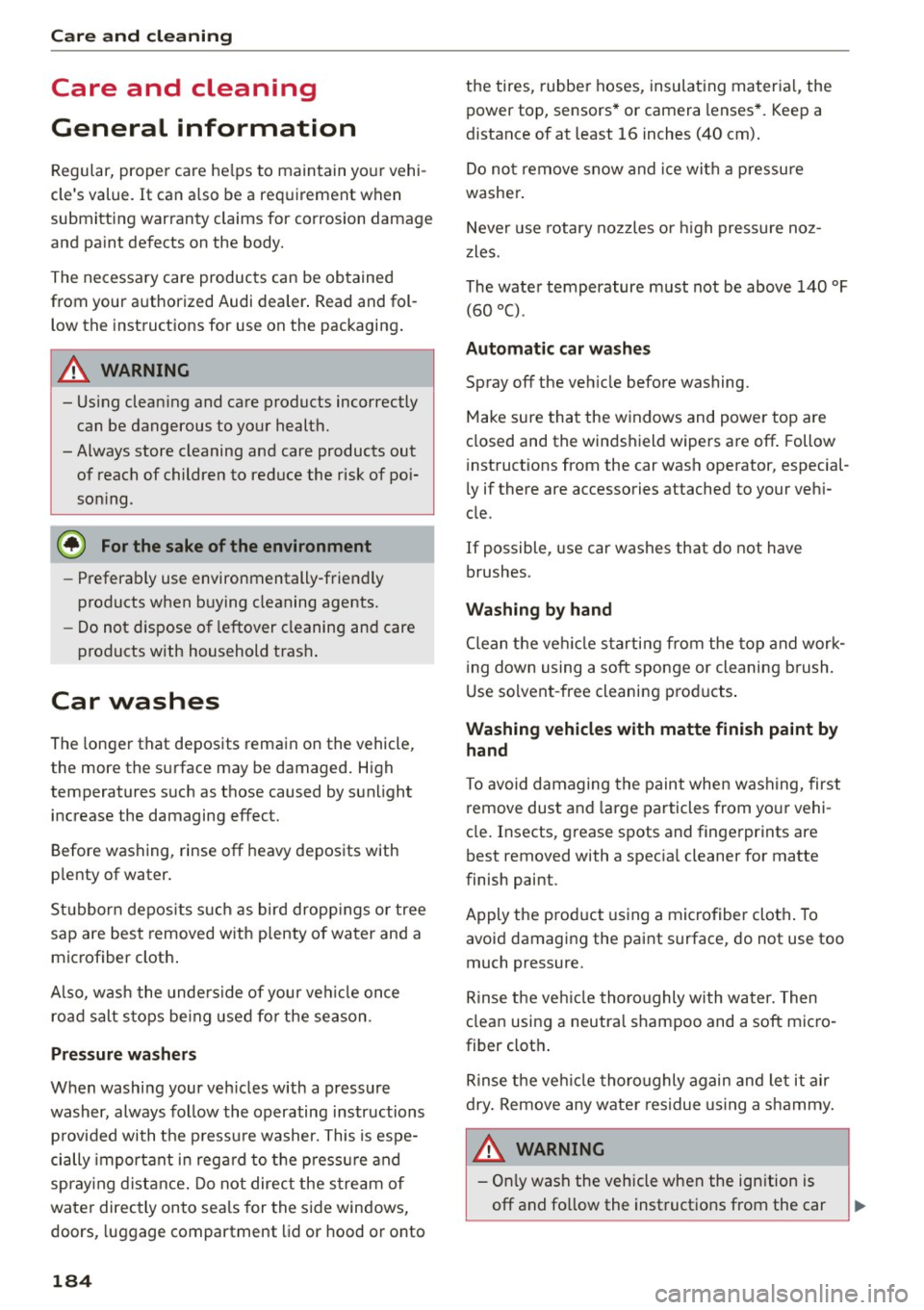
Care and cleaning
Care and cleaning
General information
Regular, proper care he lps to maintain your vehi
cle's value.
It can also be a requirement when
submitting warranty claims for corrosion damage
and paint defects on the body.
The necessary care products can be obtained
from your authorized Audi dealer . Read and fol
low the instructions for use on the packaging.
A WARNING
-Using cleaning and care products incorrectly
can be dangerous to your health.
- Always store cleaning and care products out of reach of children to reduce the risk of poi
soning .
@ For the sake of the environment
-Preferably use environmentally-friendly
products when buying cleaning agents.
- Do not dispose of leftover cleaning and care
products with household trash .
Car washes
The longer that deposits remain on the vehicle,
the more the surface may be damaged. High
temperatures such as those caused by sunlight
increase the damaging effect.
Before washing, rinse
off heavy deposits with
p lenty of water.
Stubborn deposits such as bird dropp ings or tree
sap are best removed with plenty of water and a
microfiber cloth .
A ls o, wash the underside of your veh icle once
road salt stops be ing used for the season .
Pressure washers
When washing your veh icles with a pressure
washer, always follow the operating instructions provided with the pressure washer. This is espe
cially important in regard to the p ressure and
spray ing distance. Do not direct the stream of
water directly onto sea ls for the side windows,
doors, luggage compartment lid or hood or onto
184
the tires , rubber hoses, insulat ing material, the
power top, sensors* or camera lenses *. Keep a
distance of at least 16 inches (40 cm) .
Do not remove snow and ice with a pressure
washer.
Never use rotary nozzles or high pressure noz
zles.
The water temperature must not be above 140 °F
(60 °().
Automatic car washes
Spray off the vehicle before washing.
Make sure that the windows and power top are
closed and the windshield wipers are off. Follow
instructions from the car wash operator, especial
ly if there are accessories attached to your vehi
cle.
If possible, use car washes that do not have
brushes .
Washing by hand
Clean the veh icle starting from the top and work
ing down using a soft sponge or cleaning brush.
Use solvent -free cleaning products.
Washing vehicles with matte finish paint by
hand
To avoid damaging the paint when washing, first
remove dust and large particles from your vehi
c le. Insects, grease spots and fingerprints are
best removed with a specia l cleaner for matte
finish paint.
Apply the product using a microfiber cloth . To
avoid damaging the paint surface, do not use too much pressure.
Rinse the vehicle thoroughly with water. Then
clean using a neutral shampoo and a soft micro
fiber cloth .
Rinse the vehicle thoroughly again and le t it air
dry. Remove any water residue using a sham my.
A WARNING
- Only wash the vehicle when the ignition is
off and follow the instructions from the car
-
Page 213 of 268
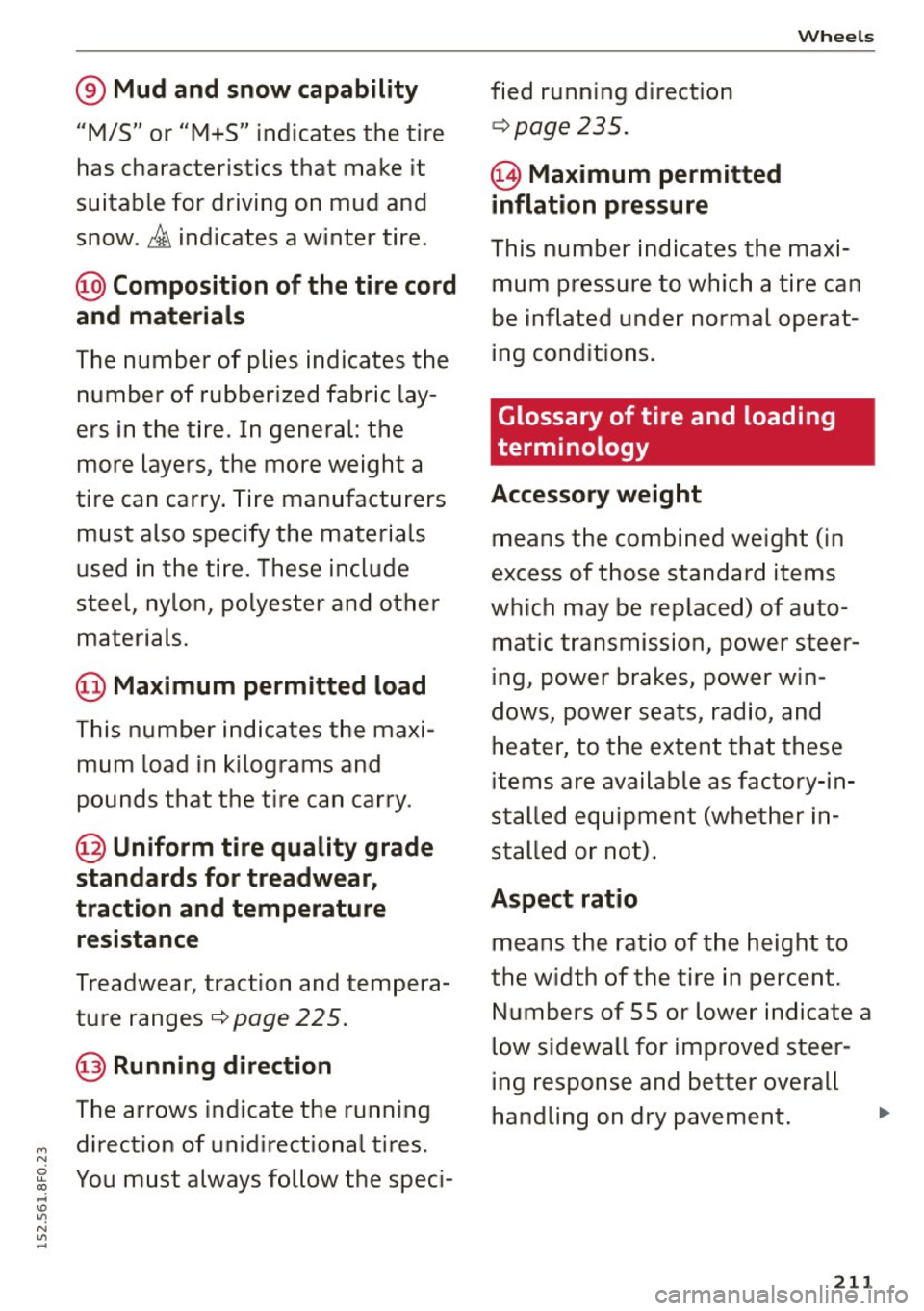
M N 0 u. "! ... IO "? N U'> .....
® Mud and snow capability
"M/S" or "M+S" indicates the tire
has characte ris tics that make it
suitable for driving on mud and snow .
& indica tes a winter tire.
@ Composition of the tire cord
and materials
T he number of plies indicates the
number of rubber ized fabric lay
ers in the tire . In general: the
more layers, the more weight a
tire can carry. Tire manufacturers
must also specify the mater ials
used in the tire. These include
stee l, nylon, polyester and other
materials.
@ Maximum permitted load
This number indicates the maxi
mum load in kilograms and
pounds that the tire can carry.
@ Uniform tire quality grade
standards for treadwear,
traction and temperature resistance
Treadwear , traction and tempera
ture ranges
c::::> page 225 .
@Running direction
The arrows ind icate the running
direction of unidirect ional tires.
You must always follow the speci- fied running direction
c::::> page 235.
€3) Ma
ximum permitted
inflation pressure
Whe els
This number indicates the maxi
mum pressure to which a tire can
be inflated unde r normal operat
ing conditions.
Glossary of t ire and loading
terminology
Accessory weight
means the combined weight (in
excess of those standard items
which may be replaced) of auto matic transmission, power steer
ing, power brakes, power win
dows, power seats, radio, and
heater, to the extent that these
items are available as factory-in
stalled equipment (whether in
stalled or not).
Aspect ratio
means the ratio of the height to
the width of the tire in percent. Numbers of 55 or lower indicate a
low s idewall for improved steer
ing response and better overall
handling on dry pavement . .,.
211
Page 214 of 268

Wheels
Bead
means the part of the tire that is
made of steel wires, wrapped or
reinforced by ply cords and that is
shaped to fit the rim .
Bead separation
means a breakdown of the bond
between components in the bead.
Cord
means the strands form ing the
plies in the tire.
Cold tire inflation pressure
means the tire pressure recom
mended by the vehicle manufac
turer for a tire of a designated
size that has not been driven for
more than a coup le of miles (kilo
meters) at low speeds in the three
hour period before the tire pres
sure is measured or adjusted .
Curb weight
means the weight of a motor ve
hicle with standard equipment in
cluding the maximum capacity of
fuel, oi l, and coolant , air condi
tioning and additional weight of optional equipment.
E x tra load tire
means a tire des igned to operate
at higher loads and at higher in-
2 12
flation pressures than the corre
sponding standard tire . Extra load
tires may be identified as "XL",
"xl", "EXTRA LOAD", or "RF" on
the sidewall.
G ross A xle Weight Rating
("GAWR ")
means the load-carrying capacity
of a single axle system , measured
at the tire-ground interfaces .
Gross Vehicle Weight Rating
( "GVWR" )
means the max imum total loaded
weight of the vehicle .
Groove
means the space between two ad
jacent tread ribs .
Load rating (code )
means the max imum load that a
tire is rated to carry for a given in
flation pressure . You may not find
this information on all tires be cause it is not required by law.
Ma ximum load rating
means the load rating for a tire at
the maximum permissible infla
tion pressure for that tire .
Maximum loaded vehicle
w eight
means the sum of: ...
Page 215 of 268

M N 0 u. "! ... IO "? N U'> .....
(a) Curb weight
(b) Accessory weight
(c) Vehicle capacity weight, and
(d) Product ion options weight
Maximum (permissible)
inflation pressure
means the max im um cold infla
tion pressu re to which a tire may
be inflated . Also called "maxi
mum inflation pressure ."
Normal occupant weight
means 150 lbs . (68 kilog rams)
times the number of occupants
seated in the veh ic le up to the to
tal seating capacity of yo ur vehi
c le.
Occupant distribution
means d istr ibution of occupants
in a vehicle.
Outer diameter
means the overall diameter of an
inflated new tire .
Overall width
means the linear dis tance be
tween the exter iors of the side
walls of an inflated tire, including
elevations d ue to labe ling, deco
rations , or protective bands or
ribs .
Whee ls
Ply
means a layer of rubbe r-coated
parallel cords .
Production options weight
means the comb ined weight o f
those installed regular production
options weighing over 5 lbs . (2 .3
kg) in excess o f those s tandard
items which they re place , not pre
viously conside red in cu rb weight
or accessory weight, including heavy duty brakes, ride levelers,
heavy du ty bat tery, and special
trim .
Radial ply tire
means a pneumat ic t ire in which
the ply co rds that ex tend to the
beads are laid at substantially 90
degrees to t he ce nterli ne of the
tread .
Recommended inflation
pressure
see ~ page 212, Cold tire infla
tion pressure .
Reinforced tire
means a tire designed to operate
at higher loads and at h igher in
flat ion pressures than the corre
sponding standard tire . Rein
f orced tires may be identified as
2 13
Page 216 of 268
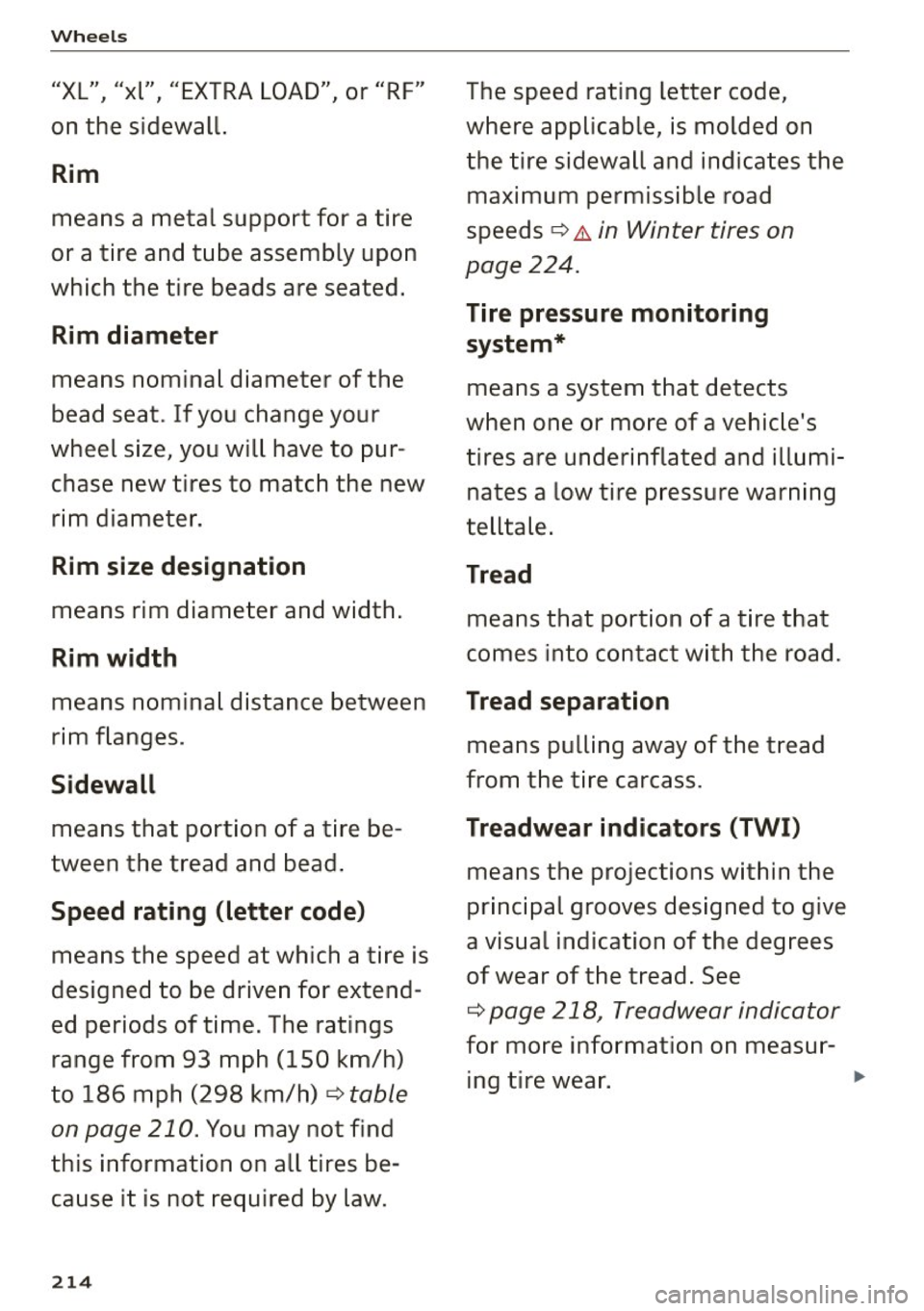
Wheels
"XL" "xl" "EXTRA LOAD" or "RF" I I I
on the sidewal l.
Rim
means a metal support for a tire
or a tire and tube assembly upon
which the tire beads are seated .
Rim diameter
means nominal diameter of the
bead seat. If you change yo ur
wheel size , you w ill have to pur
chase new tires to match the new rim diameter .
Rim size designation
means rim diameter and width.
Rim width
means nomina l distance between
rim flanges .
Sidewall
means that port ion o f a t ire be
tween the tread and bead .
Speed rating (letter code)
means the speed at which a tire is
designed to be driven for extend
ed periods of t ime. The rat ings
range from 93 mph (150 km/h)
to 186 mph (298 km/h)
¢ table
on page 210 .
You may not find
this information on all tires be
cause it is not required by la w.
2 14
The speed rating letter code ,
where applicable , is mo lded on
the tire sidewall and indicates the maximum permiss ible road
speeds
¢ .&. in Winter tires on
page 224.
Tire pressure monitoring
system*
means a system that detects
when one or mo re of a ve hic le's
tires are under inflated and illumi
na tes a low tire p ressu re warning
tellta le .
Tread
means that portion of a tire that
comes into contact w ith the road.
Tread separation
means pu lling away of the tread
from the t ire carcass.
Treadwear indicators (TWI)
means the projections wi thin the
principal grooves designed to give
a visua l indication of the deg rees
of wear of the tread . See
¢ page 218 , Treadwear indicator
for mo re information on measur
ing t ire wear.